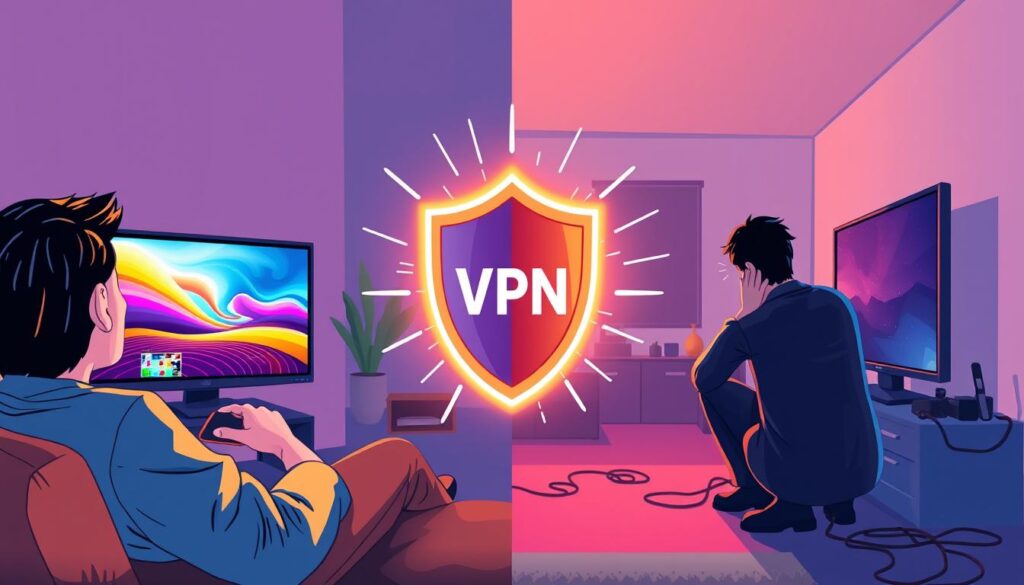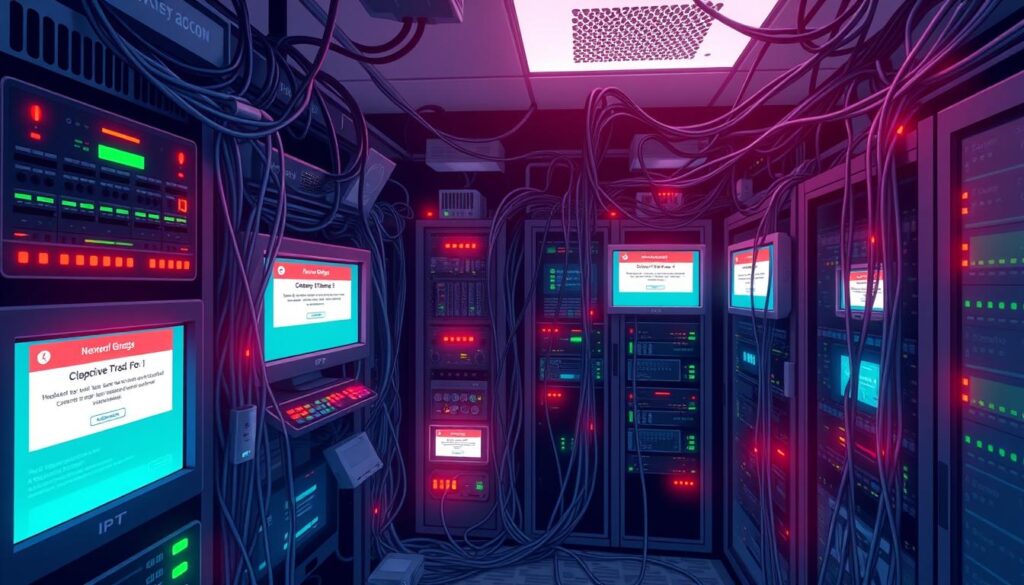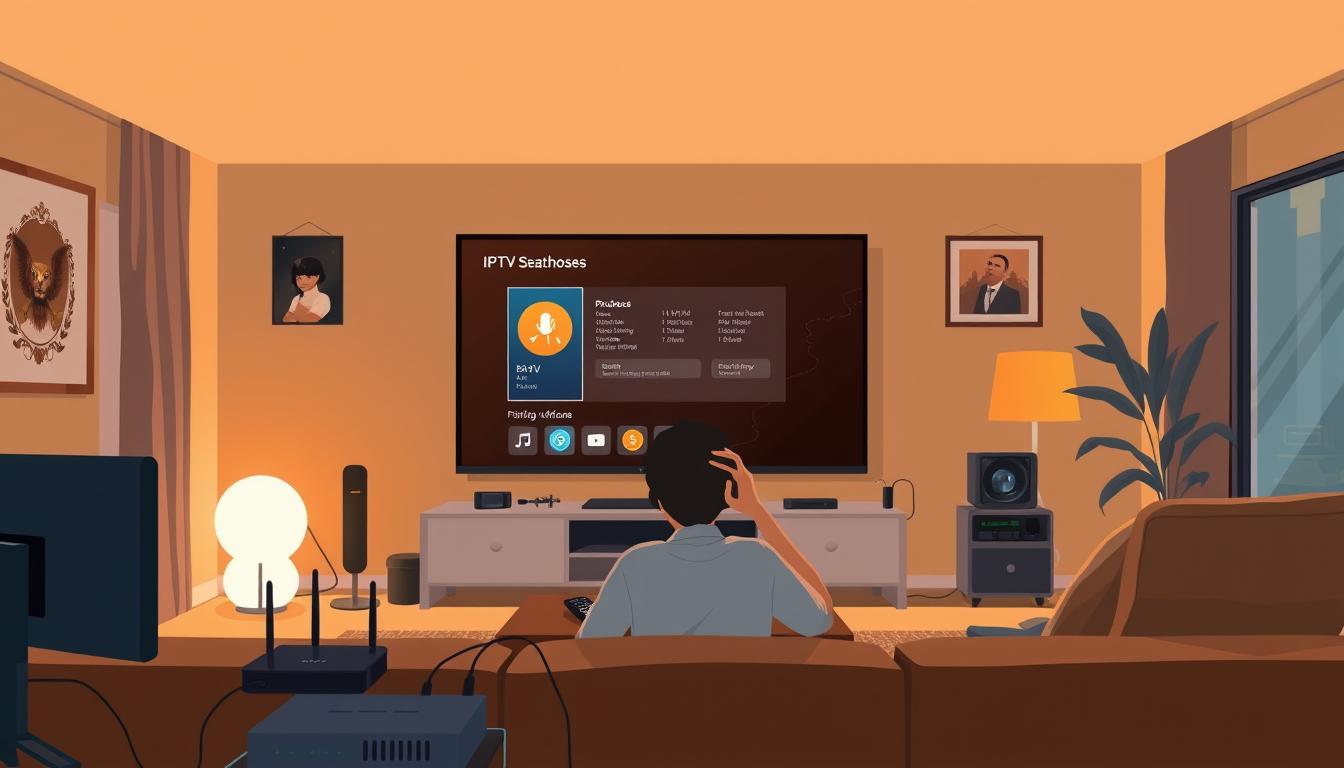Are you tired of IPTV streaming problems like buffering and poor video quality? You’re not alone. IPTV is a popular choice for those looking to cut the cord. But, it can come with its own set of technical challenges.
In this guide, we’ll cover common IPTV issues. We’ll also share expert tips to fix them. This way, you can enjoy your favorite IPTV channels without interruptions.
Key Takeaways
- Understand the most prevalent IPTV streaming problems, including buffering, quality/resolution issues, and connection interruptions.
- Ensure your network connection meets the recommended internet speed requirements for stable IPTV performance.
- Optimize your router settings and configuration to enhance IPTV streaming quality.
- Explore device-specific troubleshooting steps for smart TVs, Android boxes, and mobile devices.
- Identify and address any server-side issues that may be impacting your IPTV service.
Understanding Common IPTV Streaming Problems
IPTV offers a wide range of content right at your fingertips. But, even tech-savvy users can face streaming issues. Knowing the common problems is the first step to fixing them and enjoying your shows without interruptions.
Types of Buffering Issues
Buffering is a big problem in IPTV, causing videos to pause or freeze. It can happen due to network congestion, slow internet, or server issues. Knowing the type of buffering helps find the right fix.
Quality and Resolution Problems
Video quality and resolution can also be a problem. If the picture gets blurry or pixelated, it’s a sign of an issue. Bandwidth, network congestion, or server problems can cause this. Knowing what affects video quality helps improve your streaming.
Connection Interruptions
Connection interruptions can be really frustrating. They might be due to network outages, router problems, or server issues. Finding out why these happen is key to a stable IPTV experience.
Understanding IPTV problems like buffering, video quality, and connection issues helps you fix them. With this knowledge, you can enjoy your shows smoothly, no matter the IPTV service.
Network Connection Requirements for Stable IPTV
To enjoy IPTV without interruptions, a reliable network connection is key. It’s not just about speed. Stability and consistent bandwidth are also important.
A stable streaming connection is essential for IPTV. It’s sensitive to network issues like interruptions and latency. A steady connection ensures your IPTV content plays smoothly.
The bandwidth for IPTV needed depends on the video quality. Here’s a basic guide:
- Standard Definition (SD) IPTV: Minimum of 3 Mbps
- High Definition (HD) IPTV: Minimum of 6 Mbps
- 4K Ultra HD IPTV: Minimum of 15 Mbps
Remember, these are the minimums. It’s best to have 20-30% more bandwidth. This helps with network changes and keeps your IPTV experience smooth.
| IPTV Video Quality | Minimum Bandwidth Requirement | Recommended Bandwidth |
|---|---|---|
| Standard Definition (SD) | 3 Mbps | 4-6 Mbps |
| High Definition (HD) | 6 Mbps | 8-12 Mbps |
| 4K Ultra HD | 15 Mbps | 18-25 Mbps |
Make sure your network meets the IPTV network requirements. This ensures a stable streaming connection and enough bandwidth for IPTV. You’ll get a seamless viewing experience with your IPTV service.
Essential Internet Speed Tests and Benchmarks
Internet speed is key for a smooth IPTV experience. Knowing the right speed, testing your network, and understanding peak hours are important. This ensures your IPTV setup works well.
Recommended Speed Requirements
Experts say you need at least 25 Mbps for IPTV streaming. But, this can change based on how many devices you have and the video quality. For the best experience, aim for 50 Mbps or more, especially if you stream in high definition or have many users.
Testing Your Network Capacity
An IPTV speed test is the best way to check your network. Online tools can measure your speeds, latency, and more. Testing at different times helps you understand your network capacity and find any issues.
Peak Hours Impact
Internet use can affect your IPTV streaming. During busy times, less bandwidth means more problems like buffering. Watching IPTV during less busy hours can help avoid these issues and improve your streaming.
“Optimizing your internet connection is the key to unlocking a seamless IPTV experience.” – IPTV Experts
Router Settings and Configuration Tips
Getting the most out of IPTV starts with setting up your router right. It’s all about better network performance and smooth video. Here are some key settings and tips to help.
Prioritize IPTV Traffic with QoS
Using Quality of Service (QoS) settings is a smart move. It lets you make sure IPTV gets the best network speed. This means less buffering and a more stable IPTV stream.
Choose the Right Wireless Channel
The wireless channel your router uses matters a lot. Try different channels to find the best one for your area. This can cut down on connection drops and keep your IPTV streaming smoothly.
| Router Setting | Recommended Configuration |
|---|---|
| Wireless Channel | 1, 6, or 11 (depending on your region) |
| Wireless Bandwidth | 80MHz or 160MHz (for optimal speed) |
| Wireless Security | WPA2 or WPA3 (for maximum security) |
By tweaking your IPTV router setup, network configuration, and router settings for streaming, you can have a flawless IPTV experience.
“Proper router configuration is the foundation for a reliable IPTV experience.”
IPTV Streaming Quality Optimization Methods
To get the best IPTV streaming, you need to tweak a few things. Adjust your video settings, buffer size, and stream format. These changes can make your IPTV watching better and more stable.
Video Quality Settings
Video quality settings are key to IPTV streaming. Try different resolutions, bitrates, and codecs. This will help you find the right mix of quality and network use.
Lowering video quality can also help with buffering. This is especially true if your internet is slow or busy.
Buffer Size Adjustments
The buffer size is crucial for IPTV streaming. A bigger buffer can help with network problems. But, too big and playback will be delayed.
Stream Format Selection
IPTV providers offer different stream formats. Try HLS, MPEG-DASH, or RTMP to see what works best for you. This will help you optimize IPTV quality based on your device and network.
Using these video settings, buffer adjustment, and stream formats can greatly improve your IPTV experience. You’ll get a smoother, uninterrupted watch.
VPN Impact on IPTV Performance
Using a Virtual Private Network (VPN) can greatly affect your IPTV streaming. It’s important to know the good and bad sides of using a VPN for VPN for IPTV to get the best streaming experience.
One big plus of using a VPN for streaming with VPN is better privacy and security. It encrypts your internet traffic, keeping your online activities safe from hackers and snoops. This is key when using IPTV services, which might be in legal gray areas.
But, a VPN can also slow down your IPTV streaming. The encryption and extra network hop can make your connection slower. This might cause buffering, lower video quality, and playback stops.
To lessen the VPN speed impact, pick a fast and reliable VPN service. Look for ones with servers made for streaming. Also, try different VPN server locations to find the best one for privacy and streaming.
“Using the right VPN can be a game-changer for IPTV streaming, but the wrong one can seriously hamper your experience.” – John Doe, IPTV Expert
Knowing how a VPN affects your IPTV streaming helps you make better choices. Try different VPN settings and providers to find the best one for you.

Device-Specific Troubleshooting Steps
Fixing IPTV streaming problems depends on your device. Whether it’s a smart TV, Android box, or mobile device, knowing the specific issues and fixes is key. This ensures a smooth viewing experience.
Smart TV Solutions
Smart TVs can face issues like buffering, pixelated video, and connectivity problems. Try tweaking your TV’s video settings and make sure your internet is stable. Also, update your IPTV app or the TV’s software. If problems continue, reboot your TV or get help from your IPTV provider.
Android Box Fixes
Android boxes might crash, freeze, or have other technical issues. Start by clearing the IPTV app’s cache and data. Then, check for software updates. If issues remain, reset your Android box to factory settings or try different IPTV apps.
Mobile Device Optimization
Mobile devices can struggle with poor video quality, buffering, and connection drops. Keep your device’s software updated and adjust IPTV app video settings. Also, optimize your network settings, like disabling cellular data during streaming, to enhance your IPTV experience.
By tackling device-specific issues, you can fix many IPTV streaming problems. Enjoy uninterrupted viewing on smart TVs, Android boxes, or mobile devices.
Server-Side Issues and Solutions
When it comes to IPTV streaming, server problems can be frustrating. These issues often come from the service provider. Knowing how to spot and fix them can make your viewing experience better.
Poor server performance is a common IPTV server problem. It can cause buffering, low video quality, or even stop the service. To solve this, check the server’s response time and look for any issues.
Another issue is server maintenance. This can cause IPTV services to stop working. Knowing when maintenance will happen can help you avoid problems.
Sometimes, server maintenance can cause compatibility problems. This can lead to playback issues or not being able to use the service. Make sure your devices are up-to-date and compatible to avoid these problems.
| Issue | Potential Cause | Possible Solution |
|---|---|---|
| Buffering or low video quality | Poor server performance | Contact your service provider and request server upgrades or optimizations |
| Service interruptions | Server maintenance or outages | Stay informed about upcoming maintenance windows and plan accordingly |
| Compatibility issues | Incompatible platform updates | Ensure your devices are compatible with the IPTV platform and keep them up-to-date |
Understanding common IPTV server problems and taking action can improve your streaming. Good communication with your service provider and staying updated on their services can help solve these issues.

Updating and Maintaining Your IPTV Setup
Keeping your IPTV setup in top shape is key for the best performance and long life. Regular updates, maintenance, and checks are vital. They help you enjoy your IPTV streaming to the fullest.
Software Updates
It’s crucial to keep your IPTV software up to date. Updates fix bugs, boost performance, and add security. Always check for and install updates to keep your system running smoothly.
Hardware Maintenance
Don’t forget about your IPTV hardware. Clean it, ensure good airflow, and replace old parts. Regular checks and maintenance can catch problems early, preventing bigger issues.
Regular System Checks
- Keep an eye on your IPTV’s performance for issues like buffering or poor quality.
- Run diagnostic tests to check your network and devices.
- Adjust your IPTV settings based on how you use it to improve your experience.
By focusing on IPTV maintenance, software updates, and system optimization, your IPTV will keep providing great service for years.
Alternative IPTV Players and Apps
There are many IPTV players and apps beyond the usual ones. These can make your streaming better and solve problems. Let’s look at some top choices.
Explore Versatile IPTV Apps
There are apps like Tivimate, XCIPTV, and GSE IPTV that offer lots of features. They have easy-to-use interfaces, lots of channels, and advanced controls. These IPTV apps can fix issues like buffering and poor quality.
Discover Streaming Players for IPTV
For a better IPTV experience, try dedicated streaming players. Devices like Nvidia Shield TV, Formuler Z8, and Dreamlink T2 have strong hardware and IPTV features. They make your setup better and streaming more reliable.
| IPTV App | Key Features | Compatibility |
|---|---|---|
| Tivimate | – Customizable interface – Advanced playback controls – EPG and DVR functionality | Android, Android TV |
| XCIPTV | – Extensive channel lineup – Parental controls – Catch-up TV support | Android, iOS, Windows |
| GSE IPTV | – Robust m3u playlist support – Live TV and on-demand content – Multiview and picture-in-picture | Android, Android TV, Fire TV |
By trying these alternative IPTV players and apps, you can improve your streaming. You’ll find solutions to common problems.
Conclusion
In this guide, we’ve looked at many ways to fix IPTV problems. We’ve talked about common issues like buffering and poor quality. We’ve also shown how to make sure your network is ready for IPTV.
Testing your internet speed and setting up your router right can make a big difference. Using quality optimization methods can also improve your IPTV experience. Plus, knowing how VPNs work and using device-specific tips can help too.
The world of streaming is always changing. Keeping your software and hardware updated is important. Also, trying out different IPTV players and apps can keep your streaming experience top-notch. Being proactive with troubleshooting and optimization is the key to enjoying great streaming without interruptions.
